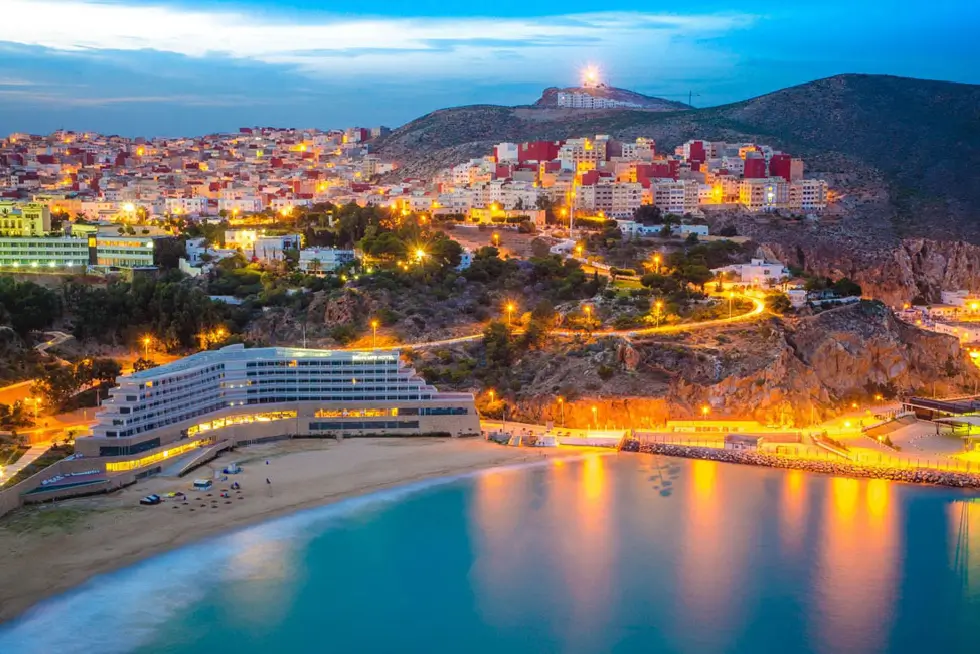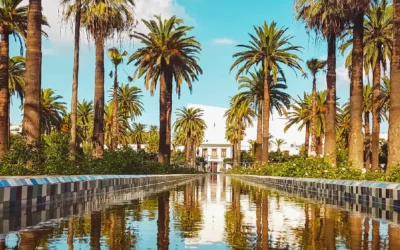Al Hoceima City, A Peaceful & Calm Retreat In Morocco

Table of Contents:
Introduction to Al Hoceima City
Al Hoceima is a peaceful and calm city, in the Tanger–Tetouan-Al Hoceima region of Morocco situated on the Mediterranean coast and cradled by the northern edge of the Rif Mountains. This city is a feast for the eyes with its breathtaking landscapes, proudly serving as the heart of Al Hoceïma Province.
Known fondly as “The Mediterranean Pearl,” Al Hoceima beckons Europeans with its promise of peaceful seaside retreats. It’s not just the tranquil shores that draw crowds; the city is also celebrated for its safety, making it an ideal spot for both relaxation and adventure.
But what truly sets Al Hoceima apart are its pristine sandy beaches. Although it’s a small city, with a close-knit community of around 57,000, Al Hoceima’s charm and natural splendor attract a multitude of visitors year-round.
Al Hoceima Discovery Tour
Al Hoceima offers a variety of popular attractions for visitors to explore:
1. Quemado Beach
Situated in the center of Al Hoceima city, Quemado Beach is known for its clear waters and clean surroundings. It’s easily accessible and located in front of a prominent hotel, making it a popular spot for both locals and tourists.
2. Al-Hoceima National Park
Just outside the town of Al Hoceima, this national park covers a significant area and offers visitors a chance to experience the area’s natural beauty and biodiversity. It’s a great spot for outdoor enthusiasts and those interested in exploring the natural landscapes of Morocco.
3. Wild Beaches and Aquamarine Waters
Al Hoceima is renowned for its stunning Mediterranean coastline, featuring wild beaches and beautiful aquamarine waters. These beaches provide a perfect backdrop for a variety of water sports or simply relaxing under the sunny skies.
4. El Peñón de Alhucemas
This extraordinary white island fortress is a significant historical site, visible from Plage Sfiha. It’s one of the plazas de soberanía (places of sovereignty) and a must-see attraction for those interested in the region’s history and culture.
5. Port Al Hoceima
Discover the heart of local life at Port Al Hoceima. It’s not just a bustling hub of maritime activity but also a picturesque spot for enjoying the Mediterranean’s azure waters. Immerse yourself in the vibrant atmosphere and savor fresh seafood at nearby eateries.
6. Beach Cala Bonita
Escape to the serenity of Beach Cala Bonita. As its name suggests, ‘Beautiful Cove’ is a haven of peace, set away from the more crowded beaches. Ideal for those seeking a tranquil retreat, its natural beauty offers a perfect backdrop for relaxation.
7. Sfiha Beach
Unwind at Sfiha Beach, a less crowded yet equally charming beach. Its clear waters are perfect for swimming, and the nearby El Peñón de Alhucemas fortress adds an intriguing historical element to your beach day.
8. Miramar Area
Experience Al Hoceima’s urban charm in the Miramar area. This lively neighborhood blends modern comforts with traditional vibes, offering an array of shops, cafes, and restaurants. It’s an excellent place for an evening stroll, with stunning Mediterranean views to accompany you.
Al Hoceima Accessibility And Transportation
Al Hoceima’s easy accessibility, and efficient local transport make it a delightful destination for any traveler seeking to experience its beauty. Here is some information about the Accessibility and transportation of Al Hoceima City:
1. Vibrant Port Life
Al Hoceima’s Gare Maritime d’Al Hoceima is more than a ferry port. Opened in 2003, it’s a bustling hub for ferries and coastal tour boats. Here, you’ll find convenient amenities like shops, restaurants, and hotels, with the beautiful Plage Quemado beach just a stroll away. The port even offers a spacious parking lot for those arriving by car. Fun Fact: Keep an eye out for dolphins frolicking in the waters nearby!
2. Ferry Connections
Travelers can catch a ferry to Motril with services operating twice a week during peak season. The journey is a manageable five-hour trip, making it an excellent option for exploring further.
3. Getting to the Port
The port’s location is ideal, nestled between Tangier and Nador and easily reachable on foot from downtown Al Hoceima. Taxis are a popular choice for those with luggage, and drivers can reach the port via Mohamed Zraktouni Avenue.
4. Beyond the Sea
Air and Road Travel Cherif Al Idrissi Airport enhances Al Hoceima’s connectivity, offering flights from key Moroccan and European cities. By road, the N2 and N16 roads, particularly the Mediterranean Bypass, link Al Hoceima to other major Moroccan destinations. However, it’s worth noting that navigating these routes can be tricky for those unfamiliar with the area.
5. Navigating Al Hoceima
In the city, taxis are your go-to for efficient travel. They’re affordable and widely available in both shared and private formats. When in doubt about the fare, always agree on a price before setting off. For those preferring to soak in the city’s charm on foot, the compact city center is ideal for walking, with key attractions just minutes apart.
Al Hoceima Economic Significance
Fishing and Tourism
The Cornerstones of Prosperity Nestled in the heart of the Tangier-Tetouan-Al Hoceima region, Al Hoceima’s economy thrives on fishing and tourism. Its stunning beaches, like Plage Quemado, draw both tourists and locals, while the maritime sector sustains the city through fish exports and the food industry.
Commercial Vitality and Cultural Blend
The city buzzes with commercial activity, from traditional souks to modern retail chains, reflecting a blend of local culture and immigrant influences.
Industrial Growth
Paving the Way for the Future Al Hoceima’s growth is tied to the broader region’s industrial development. The Tangier-Tetouan-Al Hoceima region, a strategic nexus linking several continents, has attracted substantial investment. This has led to the creation of 18 industrial zones, focusing on sectors like automotive, textile, aerospace, and electronics, contributing significantly to Morocco’s industrial GDP.
Al Hoceima History Overview
The Birth of Al Hoceima: A Fusion of Cultures
Al Hoceima stands as a testament to a rich and diverse history. Originally dominated by the Berber tribe of Ait Ouriaghel, the city’s strategic importance was recognized early on. Abd el-Krim, a notable figure from this tribe, fiercely resisted Spanish rule.
Spanish Influence and Independence
The Spanish, recognizing the area’s value, developed the town and named it Villa Sanjurjo. However, this era was short-lived. Following Morocco’s independence in 1955, the city embraced its Moroccan identity, transitioning from Villa Alhucemas to Al Hoceima.
A Time of Turmoil and Transformation
The late 1950s were marked by conflict and upheaval. Under the leadership of then-crown Prince Hassan II, the region witnessed significant military action against local rebellions. During this period, Al Hoceima’s architecture underwent a notable transformation. The city’s houses, initially adorned in the city’s official colors of white and blue symbolizing the sea and sky, began to reflect the changing times as residents opted for a variety of colors.
Resilience in the Face of Natural Disasters
Two major earthquakes within ten years, in 1994 and 2004, challenged the city’s resilience. The latter, a 6.4 magnitude quake, claimed over 560 lives. In response, a concerted effort was made in 2007 to restore the city’s traditional white and blue aesthetic, symbolizing a return to its roots and a tribute to its enduring spirit.
Al Hoceima Today: A Blend of Past and Present
Today, Al Hoceima is a vibrant city with a population exceeding 56,000. It serves as the second-largest port in the Rif region and has retained several Spanish colonial structures, including schools and a church. The city’s rich history is further exemplified by Playa Quemado, the beach where General Sanjurjo’s troops landed, now part of the luxurious Mohammed V hotel complex.
Once a Spanish-founded city in 1926, Al Hoceima has evolved into a multifaceted hub, balancing its roles as a fishing port, food-processing center, and beach resort. Its location on Al Hoceima Bay and connections to cities like Nador and Tétouan underscore its strategic and cultural significance.
Conclusion
Al Hoceima one of Morocco’s most picturesque cities, is a unique blend of cultural history, natural beauty, and tranquil seaside living, making it a must-visit destination for those exploring Morocco.
FAQ
Are there ferry services available in Al Hoceima?
Yes, travelers can catch a ferry to Motril with services operating twice a week during peak season. The port is conveniently located and provides various amenities.
Is Al Hoceima a good destination for beach lovers?
Absolutely! Al Hoceima boasts some of the most beautiful beaches in Morocco, known for their clean, clear waters and serene settings, perfect for relaxation and water sports.
A brief overview of Al Hoceima’s history?
Al Hoceima has a rich history, initially influenced by the Berber tribe of Ait Ouriaghel. It underwent Spanish rule, becoming Villa Sanjurjo, and later embraced its Moroccan identity post-independence. The city has also shown resilience in the face of natural disasters like earthquakes.
What is Al Hoceima known for?
Al Hoceima often referred to as “The Mediterranean Pearl,” is renowned for its tranquil seaside, stunning landscapes, and safety. It’s celebrated for its pristine sandy beaches and natural splendor, attracting visitors for both relaxation and adventure.
What are some must-visit attractions in Al Hoceima?
Key attractions include Quemado Beach, Al-Hoceima National Park, numerous wild beaches with aquamarine waters, the historical El Peñón de Alhucemas, Port Al Hoceima, Beach Cala Bonita, Sfiha Beach, and the urban Miramar Area.
How accessible is Al Hoceima for travelers?
Al Hoceima is well-connected through its Gare Maritime d’Al Hoceima ferry port, Cherif Al Idrissi Airport, and road links like the N2 and N16. The city is also compact and walkable, with readily available taxis for efficient travel.
What is the economic significance of Al Hoceima?
Al Hoceima’s economy thrives mainly on fishing and tourism. It’s part of the Tangier-Tetouan-Al Hoceima region, which has experienced industrial growth in sectors like automotive, textile, aerospace, and electronics.
What makes Al Hoceima unique in terms of its culture and architecture?
The city blends modern comforts with traditional vibes. Its architecture, once predominantly white and blue, symbolizing the sea and sky, has diversified over time. It retains several Spanish colonial structures, reflecting its historical journey.
What activities can visitors enjoy in Al Hoceima?
Visitors can enjoy beach activities, explore natural landscapes, visit historical sites, engage in water sports, and experience the local culture and cuisine in the city’s bustling areas.
How does Al Hoceima cater to adventure and nature enthusiasts?
The Al-Hoceima National Park offers a chance to experience the area’s natural beauty and biodiversity, making it ideal for outdoor enthusiasts and nature lovers.



